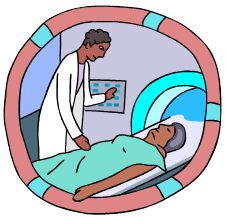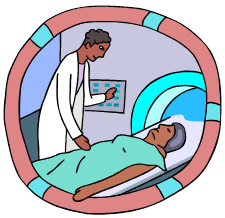
How I averted claustrophobia during an MRI exam. Mindfulness skills saved the day!
The first time I ever experienced claustrophobia took me by surprise. My doctor sent me for an MRI many years ago to find out why my jaw hurt. I didn’t know what to expect but I had no reason to worry about the small confines of an MRI machine because I had never experienced any signs of claustrophobia. When the MRI technician positioned me on the table and then slid me backwards all the way into the ‘tube’ I suddenly wanted to flail my arms and get out of there as fast as possible. My heart pounded and I felt panicky for the first time in my life.
 Thankfully the technician slid me right back out of the machine. He then asked if I needed medication to relax. I said ‘no, I think I can do this’. I then stared doing some relaxation breathing and centered myself and prepared for going back inside that ‘tube’. This time I was able to keep myself calm and was able to complete the MRI test with no further panic.
Thankfully the technician slid me right back out of the machine. He then asked if I needed medication to relax. I said ‘no, I think I can do this’. I then stared doing some relaxation breathing and centered myself and prepared for going back inside that ‘tube’. This time I was able to keep myself calm and was able to complete the MRI test with no further panic.
Over the years I have had a number of MRI tests, many of which did not require me to go in head first nor to slide all the way in. Some did require this but I never had further trouble with claustrophobia – until yesterday.
Yesterday my doctor sent me for an MRI to find out why my shoulder hurts. I was not aware of any worry about the test. I laid down and the technician handed me a bulb to squeeze if I was having any trouble.
As soon as he started to slide me into the tube and I saw the ceiling of the tube a few inches above my face my stomach lurched. Whoa! I hadn’t felt that way in years. I became aware that my heart was pounding and was beating way too fast. My mouth and throat went dry. I immediately realized I needed to calm myself down or I would need to get out of there fast.
I quickly started to use a breathing technique to calm myself down that I have taught hundreds of clients and students over the years.Here’s what I did. First, I closed my eyes and took a deep belly breath in through my nose to the count of four and then exhaled slowly through my mouth with pursed lips to the count of eight. Then I did this breath again. I could still feel my heart pounding but I already felt less anxious and my stomach started to feel better.
Then I allowed myself to breathe normally while observing the feeling of the breath. I started counting each time I exhaled. When I had counted four breaths I held one finger out and counted that as one set of four. I continued counting another four exhales and held out a second finger thereby counting a second set of four. I continued to do this for several minutes.
 Every time my attention wandered from breathing and started to focus on the fact that I was in that ‘tube’, I accepted the thought, dismissed it, and returned my attention to counting my exhales. I noticed that my heart rate slowed down to a more normal pace and my heart stopped pounding. My shoulders, my face, and my legs began to relax. There was moisture in my mouth again. I began to feel a sense of comfort and instead of feeling confined in a tiny space I felt like I was snuggled into a safe cocoon.
Every time my attention wandered from breathing and started to focus on the fact that I was in that ‘tube’, I accepted the thought, dismissed it, and returned my attention to counting my exhales. I noticed that my heart rate slowed down to a more normal pace and my heart stopped pounding. My shoulders, my face, and my legs began to relax. There was moisture in my mouth again. I began to feel a sense of comfort and instead of feeling confined in a tiny space I felt like I was snuggled into a safe cocoon.
As the noises of the MRI test bombarded me with clicking, tapping, whirring and popping sounds I noticed them but returned by attention to counting my breaths. I was able to float through the rest of the test and slowly became drowsy and drifted in and out of sleep.
Of course, as soon as I knew I needed to lie still, my nose started to itch. When I noticed the itch I acknowledged it and then just observed it while I continued to count my exhales. Slowly the itch subsided. Another spot started itching. Again, I observed it and returned my focus to counting my breaths. Again the itching subsided. I eventually realized than nothing was itching at all and I felt comfortable and relaxed.
Although I have been teaching and using these breathing techniques as part of a mindfulness practice for years, it was so comforting to see how effective they were for me when I used them for a very practical application. I also realize that they worked so easily and effortlessly for me partly because I had practiced them when I wasn’t experiencing any panic or claustrophobia.
Try these breathing techniques I used for yourself. Research shows us that practicing these kinds of mindfulness skills improve our physical, emotional, and spiritual health. And they might just make your next MRI experience a whole lot easier!
Check out the meditations on the Mindfulness Toolkit CD/mp3 to help you practice the relaxation breath and other mindfulness skills that will help you relax and stay calm.













